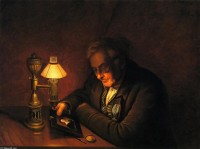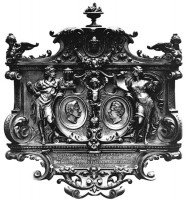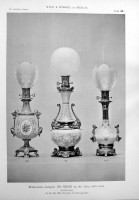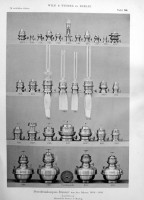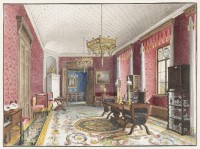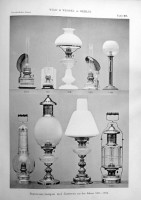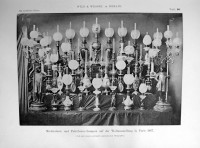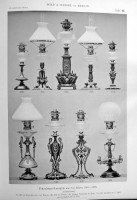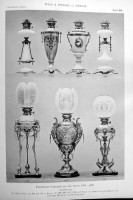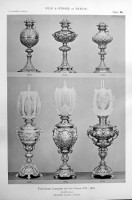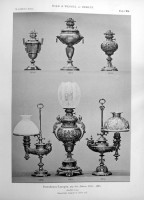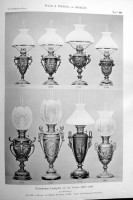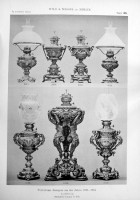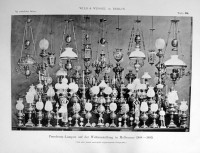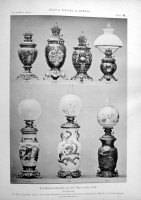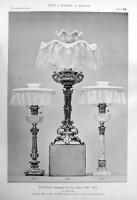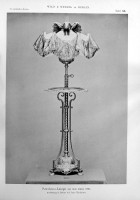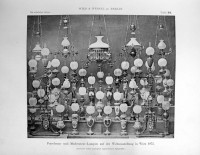The browser will either open the file, download it, or display a dialog.
Few domestic conveniences in the long nineteenth century experienced such rapid and constant transformation as lights. By the end of the eighteenth century, candles and traditional oil lamps—which had been in use since antiquity—began to be superseded by a new class of oil-burning lamps that, thanks to a series of improvements, provided considerably more light than any previous form of indoor lighting. Plant oils (Europe) or whale oil (United States) fueled these lamps until, by the middle of the nineteenth century, they were gradually replaced by a petroleum derivative called kerosene. Though kerosene lamps remained popular until well into the twentieth century (and in some places until today), by the late nineteenth century they began to be supplanted by gas and electrical lights. The evolutionary arc from candle to electrical light was punctuated by a myriad of inventions all geared to make lamps brighter, cleaner, more efficient, and easier to maintain, as well as to make their production more streamlined.
Kerosene lamps became the standard artificial light source during the second half of the nineteenth century. Brighter than oil lamps, they allowed for an increase in productivity, as well as more time for family and social life, especially in countries where daylight, in winters, was short. As the author of an article on kerosene lamp factories in Berlin marveled in 1892, “how many places of busy work and intimate coziness obtain their light from this source!”[1] Kerosene lights were found in all rooms of the house and their designs were adjusted to the function they served in that room. Living and dining rooms had large decorative lamps casting a wide light; studies had smaller, focused reading lights. Lamps for kitchens and utility rooms were simple, unadorned, and made of inexpensive materials, like tin and zinc. While most early lamps were table lights, by the end of the nineteenth century hanging and floor lamps also became popular.
The increased demand for lights created an ever-growing supply. Whereas in the first half of the nineteenth century, France had dominated lamp production in Europe, after the 1850s, coinciding with the switch to kerosene, Germany became the center of lamp manufacture. In 1889, Berlin alone counted twenty-seven lamp factories and, according to at least one contemporary source, led the world’s kerosene lamp production.[2] Competition between producers was keen. To succeed, factories needed to focus at once on lamp technology and aesthetics, as well as on catering to the broadest possible market, ranging from low to high.
This article is focused on one Berlin factory, Wild & Wessel (henceforth W&W). One of the most successful lamp factories in Berlin in the second half of the nineteenth century, it owed its success to a business model that had its roots in the effective entrepreneurial model developed by Josiah Wedgwood (1730–95) in England during the eighteenth century. According to Derek Lidow, professor of entrepreneurship at Princeton University, Wedgwood’s success in the ceramics industry depended on six broad strategies: expansion of technologies, quality of design, streamlining of production, and improvement of marketing, merchandising, and sales.[3] Lidow explains that Wedgwood was continuously experimenting with his raw material, clay, adding ever new elements to it, to ultimately develop his famous Jasperwares. In addition, he was always perfecting his glazes. As far as design was concerned, he hired major artists of the period, most importantly John Flaxman (1755–1826), to design his high-end wares. At the same time, he produced good-quality low-end ceramics—his cream ware—for daily use. Wedgwood streamlined production by instituting a sharp division of labor, replacing the traditional “start to finish” production by masters and their apprentices with a production line. As for merchandising, Wedgwood developed the first modern store, in which a wide variety of products and designs were artfully displayed on tables and shelves. He used experienced salespeople, as well as traveling representatives. According to Lidow, Wedgwood was also the first to create name brands, such as Queen’s Ware, so called with the permission of Queen Charlotte (1722–1818), and Jasperware, named after jasper stone.[4]
As this article demonstrates, W&W’s two founding partners, Emil Wild and Wilhelm Wessel, to a greater or lesser extent followed all the strategies developed by Wedgwood. Their highly innovative patented Kosmos burner was a global technological and commercial success. Constantly updated, improved, and rebranded, it remained popular throughout the second half of the nineteenth century and beyond. Their focus on technology was matched by their attention to design. They spent large sums of money to hire the best decorative sculptors and architects in Germany to design and prototype their high-end lamps and skilled modelers to create the plaster or wooden molds in which they were cast. They also closely followed the fashion trends of the period and regularly came out with new lines of lamps in ever-different styles. At the same time, they produced low-end, plain, utilitarian lamps to reach the broadest possible clientele. As for marketing, the firm participated in nearly every International Exhibition held in the second half of the century, exhibiting large numbers of lamps with a great deal of fanfare.
We are exceptionally well informed about W&W because, in 1894, the factory’s founding directors published the two-volume Wild & Wessel, Fünfzig Jahre in der Lampen Industrie: Ein Rückblick (Wild &Wessel, Fifty years in the lamp industry: A retrospective).[5] The first volume contains plates with photogravures of the lamps the factory produced. The second traces the two partners’ joint venture in lighting manufacturing from their apprenticeship years through the peak of their success in the 1890s, providing a detailed history of one of the largest European lamp factories of the second half of the nineteenth century. This article is based on a careful reading of this unique document, as well as the examination of other literature from the period. It is also the product of my years of collecting W&W lamps and study of pieces in museums and private collections. The article begins with a brief overview of the development of oil lamps from the late eighteenth through the nineteenth centuries, then focuses on the history of W&W, in particular on its founders’ strategy of maximizing technology, design, and marketing.
The Oil Lamp in the Long Nineteenth Century
The invention of the kerosene lamp is rooted in a series of innovations made to the traditional oil lamp, starting in the late eighteenth century. In the early 1780s, the Swiss chemist Francois-Pierre-Amédée Argand (1750–1803) made a string of modifications (mostly focused on the improvement of air flow) to the then still fairly primitive oil lamp, causing it to burn five to ten times brighter than before.[6] The new lamp became known as the Argand lamp. In 1784, the French pharmacist Antoine-Arnoult Quinquet (1745–1803) introduced a glass chimney to stabilize and enhance the flame, making it brighter. Quinquet’s lamp, seen in Charles Willson Peale’s painting of James Peale (1822; fig. 1), was remarkably successful and also received its inventor’s surname.
In both the Argand and the Quinquet lamps, the font containing the fuel is mounted above the burner, so that gravity forces the viscous oils used—rapeseed oil in central Europe, olive oil in southern Europe, and whale oil in the United States—to reach the wick.[7] Placed next to the light, the font casts an undesirable shadow. In 1800, the French watchmaker Bernard-Guillaume Carcel (1750–1818) used the same burner but applied a clockwork mechanism to the base of the font to pump the oil toward the wick.[8] Another solution to the shadow problem was patented, in 1805, by the Swiss engineer, industrialist, and inventor Isaac-Ami Bordier-Marcet (1768–1835), whose Astral lamp had a round font and arms to feed the flame. Marcet’s idea was perfected in 1809 by the English inventor Samuel Parker, who created a lamp known as Sinumbra, or “without shadow” (fig. 2).[9] Twenty-seven years later, on October 8, 1836, the French engineer Charles-Louis-Félix Franchot (1809–81) patented the modérateur (moderator). Its font contains a spring and a leather piston to press the fuel toward the wick along a tube with a needle moderating the flow, hence the lamp’s name (fig. 3). This lamp burned more economically than the previous ones, but initially most people could not afford it. Nevertheless, it was considered the “queen of lamps” (la reine des lampes) of the first half of the nineteenth century.[10] The last oil lamp to be invented was the Solar, created in the United Kingdom around 1837–38. It was based on the principle of the Sinumbra, but it had a bulgy font, placed immediately below the burner. This lamp, also produced in France and the United States, was perfected by the US inventor and industrialist Robert Cornelius (1809–93), best known as a pioneer of photography (fig. 4).[11]
Fig. 2, Sinumbra lamp, ca. 1835. The Metropolitan Museum of Art, New York. Artwork in the public domain.
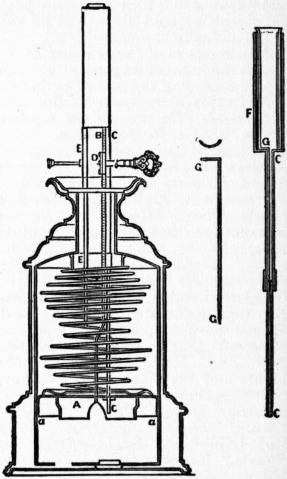
Fig. 3, Sectional diagram of moderator lamp. Illustration for article on “Lighting,” in Encyclopædia Britannica, 11th ed. (New York: Encyclopaedia Brittanica, 1910–11), 16:652. Artwork in the public domain.
Fig. 4, Cornelius & Co., Solar lamps, 1843–60. Author’s collection, Lisbon. Photo by the author.
In 1851, Pennsylvania-born Samuel Martin Kier (1813–74) invented a method to refine petroleum into a clean-burning fuel called kerosene and founded the Kier Refinery.[12] He also developed and fabricated a lamp suitable for its use. His experiments soon reached Europe and, in 1853, the Polish pharmacist Jan Józef Ignacy Łukasiewicz (1822–82) made the first European kerosene lamp.[13] It was a watershed moment in the history of domestic lighting: kerosene was cheaper than plant oils or whale oil, and kerosene lamps were easier to operate and clean. By 1865, two of the most manufactured and widespread burners were invented: Duplex, by James Hinks & Son Ltd. from Birmingham (copied by Evered & Co. and Messengers in the same city),[14] and Kosmos by W&W from Berlin.
It was in Germany that the factories producing kerosene lamps and burners became most numerous. The lucrative lamp industry thrived, especially following the unification of Germany and the creation, in 1877, of the Kaiserliche Patentamt (Imperial Patent Office). In 1889, there were thirty-one kerosene lamp factories in Germany—twenty-seven in Berlin, one in Erfurt, one in Sebnitz, one in Chemnitz, and one in Neheim[15]—and by 1893 the number had risen to forty-three.[16] After 1900, however, kerosene was gradually replaced by gas and electricity and most of these factories closed.
The Foundation of W&W
Born in Schweidnitz in Silesia (today Świdnica, Poland), Heinrich Otto Emil Wild (1826–96) and Friedrich Wilhelm Wessel (ca. 1830–98) started their careers in the lamp industry by working for the well-known manufacturer of moderators Noël Bosselut in Paris. In his factory at the quai Valmy, Bosselut produced “rich bronze moderator lamps in all styles.”[17] They remained in Paris until 1853, then visited London, and in May 1854 settled in Berlin. One of them was employed by Stobwasser Manufaktur, a famous lacquer manufacture, founded in 1763, that later also produced oil and kerosene lamps; the other was hired by Th. Guiremand, a factory that embossed copper, brass, and nickel items.[18] The experience they acquired in Paris was essential for the subsequent establishment of their own factory back in Berlin. On July 1, 1855, the two men formed a partnership and founded, in Alexandrinenstrasse no. 37, the lamp factory W&W. In 1858, the headquarters were moved to Prinzessinnenstrasse no. 26, also in Berlin,[19] where they remained until the plant’s closure in 1903 (fig. 5).
At first, W&W focused on the production of moderators and Quinquet lamps, clearly inspired by their time in Paris. It was difficult, however, to find craftsmen in Berlin who could make the molds to cast the lamp’s metallic parts. This led the partners initially to order moderators from Parisian manufacturers, but the problem was soon overcome and the metal parts were produced in Berlin. The first moderators fabricated by W&W (fig. 6) had porcelain bodies with bronze mounts, some of which were screwed into the porcelain, which was a precarious process. W&W moderators became very successful; their production reached 8,000 to 10,000 per year during the heyday of their popularity in the 1860s, but eventually it decreased and stopped altogether in 1875.[20]
Around 1858, the factory started experimenting with photogen, a fuel obtained by the distillation of bituminous shale, coal, or peat,[21] which led to the design and production of its own burners. These had flat or round wicks (like Solar and moderator lamps) and mushroom-shaped spreaders. Due to the inexpensive metals used to produce these lamps, they were accessible to a great number of buyers, but the high volatility of the fuel and the unpleasant smell made their success short-lived. The experiments with these photogen burners were crucial, however, for the creation of the Kosmos burner, which is fueled by kerosene. Kosmos was a round-wick burner put on the market on June 22, 1865.[22] Though the company’s patent application was twice rejected in Prussia, the Kosmos was patented soon after in France, where it became known as the “Prussian burner” (bec prussien),[23] and in Britain.[24]
Technology
W&W’s branded Kosmos burner represented a significant turning point in the production of kerosene lamps (fig. 7). Because it uses a flat wick that turns into a cylinder as it passes through the burner, it allows for a small burner to produce a big light. The burner also has an ingenious draught system. Although the Kosmos burner was soon copied by other factories, W&W’s burners were in high demand due to their superior quality: the brass was solid, the welding did not break (as it did in some copy-cat burners), and the flame was more stable, tapered, and longer than that of the others. Furthermore, it did not soot the chimney, which made regular cleaning unnecessary.
W&W continued to make improvements to the Kosmos burner, taking out patents for new burner lines with strong brand names such as Central, Vulkan (Vulcan), and Universal.[25] Nearly all burner lines were made in several different sizes. As late as the early twentieth century, the factory launched a burner called Kronos (the father of Zeus in Greek mythology), the external design of which is partly similar to that of the Kosmos-Normal line.[26] The spreader is cylindrical, with perforations and a hat, and the wick and reel are identical to the ones used in the Vulkan line. It was produced in sizes 14, 16, and 20 corresponding to the light given by each burner, and generated the factory’s last known product line, the Agni (the Hindu god of fire).[27] The commercial success of all these burners was the result of rigorous research and development and several months of testing before they were launched on the market.[28] Their market value was high, sometimes higher than that of entire lamps.[29]
W&W sold burners to lamp manufacturers all over Europe, as well as to individual specialty craftsmen. The French jeweler Lucien Gaillard (1861–1942) used a silver-plated Kosmos burner, size 10, in a one-of-a-kind table lamp in Louis XV style (fig. 8). This rare, high-quality piece also incorporates a clock from the US company Parker & Whipple Co. (1823–1975), from Meriden, Connecticut. It was sold through the prestigious Maison Boudet, in Paris, to Queen Maria Pia of Portugal on November 9, 1893, and is today in the Ajuda National Palace in Lisbon.
Fig. 8, Lucien Gaillard, Kerosene lamp, ca. 1886–93. Ajuda National Palace, PNA, inv. 42640, Lisbon. Photograph by José Pessoa, (PNA 16145 TC), 1996, Direção-Geral do Património Cultural / Arquivo de Documentação Fotográfica (DGPC/ADF).
Kerosene Lamps as Kunstgewerbe[30]
The invention of the Kosmos burner coincided with increased attention at W&W to the aesthetic aspects of the lamps the company produced. As the partners explain in their book, lamps, often placed in the center of the room (fig. 9), clearly fell into the domain of the Kunstindustrie, an industry that emphasized the artistic quality of its products.[31] The artistic quality of their high-end lamps was of paramount importance to Wild and Wessel. But, like Wedgwood, they understood that to be financially successful they had to cater to the lamp market as a whole. Just as Wedgwood produced both “ornamental” wares and “useful” ceramics, W&W produced ornamental and useful lamps.[32] Plate 27 in W&W’s book (fig. 10) shows several examples of lights that were made for the living rooms, kitchens, bedrooms, stables, and outhouses of the lower middle and working classes.
Kerosene lamps were more difficult to design than moderators because they required a large and wide font immediately underneath the burner, which, in turn, necessitated a large foot to give stability to the lamp. In addition, like all oil lamps, they needed to have a “grip” so that one could pick up the lamp and move it around. While W&W’s moderators, generally, had a classical design, their kerosene lamps were more eclectic. Their fonts, which in the beginning were often made of glass, stood on a base with elaborate feet. In some models, the feet were all metal; in others they were a combination of metal with ceramic. The forms these lamps took were innovative. Some included freestanding human sculptures, such as the two candelabras with male figures holding gothic-style fonts in figure 11; others took the forms of vases, tripods, or chalices. Lamp model no. 955 (fig. 12), created in 1866, resembles the pedestal of a statue. Its base is decorated with trophies and eagles, evoking the coat of arms of the Prussian royal family, and the pedestal holds the effigy of King Wilhelm I (1797–1888) inside a cameo. After the Franco-Prussian War (1870–71), an iron cross was added to the cameo to celebrate Prussia’s victory over France.[33]
The factory was proud of its investment in the artistic aspects of their lamps and paid about 20,000 marks per year to decorative sculptors, modelers, and architects to develop attractive designs and prototypes for their lamps.[34] It appears that in some cases architects designed the lamps (Entwürfe) and sculptors created the prototypes (Modelle), from which modelers made casting molds. In other cases, sculptors were alone responsible for the design and prototype of a lamp. Many of the artists working for W&W were well known in their time.[35] Albert Wolff (1814–92), who made the prototype for lamp model no. 847 (fig. 13), was a professor at the Prussian Art Academy since 1866. He was responsible for numerous public monuments and sculptures in Berlin and elsewhere, including the famous Lion Fighter outside the Altes Museum in Berlin.[36] Otto Lessing (1846–1912), who made the prototypes for four lamps designed by the architect Alexander Schütz (see below) in figure 14, was a distinguished artist who contributed decorative sculptures to the Reichstag as well as Berlin Cathedral. In 1911, he was made a member of the Senate of the Prussian Academy of Arts.[37]
Though W&W called on numerous German artists to conceptualize their lamps, they most heavily relied on the decorative sculptor and modeler Hugo Zacharias (??–ca. 1890) and the architect Alexander Schütz (1847–92). A native of Erfurt, Germany, Zacharias had a full-time job as a decorative sculptor-modeler with the silver and gold smithing company of François Louis Jeremie Sy and Emil August Albert Wagner in Berlin, but he also freelanced for W&W. According to the two partners, Zacharias was “the first sculptor-modeller who was interested in adjusting [his art] to our needs.”[38] Although he had academic training, many of his designs for Sy and Wagner are inspired by the gothic style,[39] but his lamp designs (about a dozen for W&W) show a more eclectic approach (see models 710 and 609 in fig. 12).
The Hanover-born architect Alexander Schütz was a teacher at the Kunstgewerbemuseum (Museum of Industrial Arts) in Berlin.[40] He was responsible for the design of numerous high-end lamps inspired by decorative patterns of the Renaissance and the baroque period.[41] Unlike Zacharias, who designed and prototyped his lamps, Schütz only made the designs, which were then prototyped by sculptors or modelers. A number of the lamps designed by Schütz were executed in bronze, a material he favored because in his youth he had worked for the bronze manufacture of J. C. Spinn & Sohn.[42] Bronze was difficult to work and expensive, so the bronze lamps of Schütz’s design were out of most people’s reach. King Ludwig II of Bavaria, however, was impressed by their beauty and high quality and purchased several for his palaces, including lamp no. 1245 reproduced in figure 15; he also bought Schütz’s lamps to offer as gifts.[43]
Schütz designed one of the most iconic lamp models produced by W&W, a reading lamp called Vesta. It is shaped as a Roman oil lamp with a side handle and was patented on February 13, 1879.[44] The Kosmos burner, size 12, was redesigned for this lamp and a new opening was added for the air to run through a central tube, as in the Quinquet lamps, in order to enhance the flame’s brightness. The lamp was usually placed on desks and was a favorite of students. After it was patented, the font was equipped with an arm and a handle on top so that the lamp could be moved, as is seen in the examples in figures 15 (1373 and 1614) and 16.[45] Despite their significant cost, 10,000 Vesta lamps were produced within the first fifteen years of its market launch. They were sold in Germany and exported to many European capitals,[46] as well as the United States, where they became known as Harvard Student Lamps. They are praised in Franz Sales Meyer’s A Handbook of Ornament for their practicality: their height can be adjusted and they are easily filled and cleaned.[47]
Fig. 16, Wild & Wessel, Vesta lamp, model 1373, ca. 1879–1903. Author’s collection, Lisbon. Photo by the author.
Wild and Wessel, in their book, mention that, together with Schütz, they visited the Kunstgewerbemuseum in search of inspiration for lamp designs, and with Zacharias they visited the Royal Museums on Berlin’s Museum Island.[48] Because the formal requirements of lamps were so different from those of traditional Renaissance and baroque objects, they comment that it was difficult to achieve stylistic purity.[49] When looking closely at W&W lamps, one can often detect one or two main sources of inspiration, eclectically combined with elements from other stylistic periods. While the Vesta lamp was inspired by Roman oil lamps when it came to its main form, its decorations were often derived from those of Renaissance objects. Other lights took their forms from Greek vases (model 1111 in fig. 17), Greek and Roman tripods (e.g., Wolff’s lamp model 817 in fig. 13), classical columns (fig. 18), medieval chalices (model 1452 in fig. 15), or Renaissance and baroque Deckel Pokale (lidded goblets; figs. 19–22), but their decorations were not necessarily a stylistic match, except in the latter case. The Rollwerk (scroll work) in the Renaissance and baroque goblet lamps offered elaborate surfaces and handles decorated with sirens and fantastic animals.
Fig. 18, Wild & Wessel, Kerosene lamps, models 2420 and 2301&2 (center and right), manufactured 1890–1903. Author’s collection, Lisbon. Photo by the author.
Fig. 19, Wild & Wessel, Kerosene lamps, models (left to right) 1409, 1155, and 1746, manufactured 1870–1903. Author’s collection, Lisbon. Photo by the author.
Fig. 20, Wild & Wessel, Kerosene lamp, model 1849, ca. 1870–1894. Pena National Palace, PNP, inv. 662, Sintra. Photograph © PSML | João Krull.
Fig. 21, Wild & Wessel, Kerosene lamp, model 1766, ca. 1870–1903. Author’s collection, Lisbon. Photo by the author.
One of the most impressive examples of baroque richness, if not excess, is model no. 1666 (fig. 22) designed by Max Wiese (1846–1925), professor and later director of the Zeichenakademie (Drawing Academy) in Hanau, Germany. From the base—reminiscent of a baroque candle stick—rise three caryatids supporting the oil font. With their raised hands, they grab the center of the volute of a Corinthian capital. The font is surmounted by one of the largest burners in the Kosmos-Vulkan line. It is hardly surprising that this model should have occupied a prominent place in the factory’s display at the Melbourne Centennial Exhibition (fig. 23).
While W&W produced high-end bronze lamps, the majority were made of zinc, which was cheap, easy to model, and allowed for fine detailing.[50] Electroplating permitted the firm to cover the lamps’ zinc elements with copper, brass, or nickel. As for the use of silver, collectors have only come across silver-plated burners. Most of the lamps put on the market were plated with yellow copper, but the factory also used copper or brass plating that was greenish or brown. The so-called Braun Barbedienne (Barbedienne brown), named after the characteristic patina developed by the famous French bronze founder Ferdinand Barbedienne (1810–92), was especially popular. This plating created an “antique” look and was widely used in almost all the lamps’ metallic pieces until 1894.[51]
Some lamp bodies were made of glass, porcelain, or majolica, but these were not produced in the Berlin factory. On January 1, 1872, W&W set up a glass factory in Wiesau, in Prussian Silesia, for the production of bodies, fonts, shades, chimneys, and other glass elements used in its lamps.[52] Porcelain and majolica bodies were imported from Bohemia, Hungary, and even as far away as Japan (figs. 24–25). Some of these bodies were bought as vases, which were turned into lamps in the factory; others were specifically produced for the lighting industry.
Fig. 25, Wild & Wessel, Kerosene lamp, unknown model [base marked model 2021, which was also used on models 2502 and 2770], ca. 1890–94. Pena National Palace, PNP, inv. 1123, Sintra. © PSML | João Krull.
While abundant and eclectic decoration was the hallmark of W&W lamps during their first thirty-five years, by the late 1880s the factory began to produce plainer lamps. The so-called säulenformige Lampen (pillar-shaped lamps) featured Doric, Ionic, or Corinthian columns rising from round or square bases and surmounted by glass or metallic fonts (figs. 18, 26). Pillar lamps quickly found a market in France,[53] but the German public was at first unresponsive. Gradually, however, they became popular and W&W started producing them in large numbers by 1890.[54] The bases and capitals were cast in metal in different styles (classical, Renaissance, baroque). The columns were made of red marble, Brazilian onyx, serpentine stone, malachite (or an imitation thereof), or majolica. The parts of the lamps could easily be interchanged, allowing for a wide variety of choices and even the possibility of custom-made lamps. Most pillar lamps had silk and lace lampshades, which were very popular from the mid-1880s onward. These lampshades were also used in the floor lamp, a new model that became popular in the 1890s. Such lamps were placed next to pianos, sofas, or fauteuils (armchairs) to light the surrounding area. They had a large burner and could be adjusted to different heights. Some models even included tabletops, shelves, and compartments for magazines and newspapers (fig. 27). The silk shades were used to obtain a soft, diffuse light.
Marketing and Merchandizing
In addition to maximizing technology and design, Wild and Wessel, like Wedgwood, also paid much attention to marketing. Initially their marketing strategy was closely bound with the new phenomenon of national and international exhibitions. Indeed, they participated in fourteen exhibitions, including the 1862 International Exhibition in London, the 1867 International Exhibition in Paris, the 1873 International Exhibition in Vienna, the 1888–89 Melbourne Centennial Exhibition, and 1893 World’s Columbian Exhibition in Chicago.[55] Eventually, the partners, like other manufacturers, realized that the cost of participation in the exhibitions was not offset by the profits resulting from them, and their enthusiasm for the international exhibitions diminished.[56]
At the 1862 International Exhibition in London, Wild and Wessel followed the instructions sent to participants to submit products that were affordable by the general public.[57] The factory exhibited twelve moderators, eight Quinquet desk lamps (called sliding lamps because the adjustable light was mounted on a rod), two kerosene lamps, and twelve kerosene burners. Most of them were low- to medium-priced lamps that catered to a broad segment of the market. But because their exhibit lacked spectacularism, it attracted few visitors.
Five years later, for the 1867 Paris Exhibition, the partners prepared a stunning exhibition (fig. 11). The selection of lamps—twenty-one moderators, fourteen lamps with Kosmos burners, and two candelabras, each with four Kosmos burners—showed a variety of styles and materials.[58] The partners had purposefully included high-quality moderators to compete with their Parisian counterparts. But the focus on kerosene lamps was intended to show the technological superiority of W&W and the diversity of materials translated into a broad range of prices.
The lamps were displayed on shelves, arranged stepwise and covered with fabric. The bottom shelf was flanked on either side by two tall lamps showing male figures in medieval tunics and berets, holding candelabras with four kerosene lamps each. Between them, other kerosene lamps alternated with moderators. The second shelf from the bottom contained only moderators, while the remaining two were occupied by kerosene lamps and moderators. The center of the top shelf was reserved for model no. 11, a huge kerosene lamp with a grip in the shape of the figure of Atlas and the font the celestial sphere he carries on his shoulders.
In the historic overview of their company, Wild & Wessel, Fünfzig Jahre in der Lampen-Industrie, Wild and Wessel relish the memory of the Paris Exhibition award ceremony in the Palais d’Industrie (Palace of Industry). The event was attended by Napoléon III and Empress Eugénie, and their royal guests, including the Prussian crown prince, later Emperor Friedrich III. An orchestra and choir performed the Hymne à Napoléon III et à son vaillant peuple (Hymn to Napoleon III and his valiant people) by the Italian composer Gioacchino Rossini (1792–1868) and the emperor himself gave the award speech.[59] Doubtlessly, the partners also fondly remembered the ceremony because they received their first International Exposition medal.[60]
At the 1867 Paris exhibition, Wild and Wessel only showed table lamps. This limitation was rectified at the 1873 International Exhibition in Vienna, where the company also showed floor and hanging lamps. Their carefully orchestrated display (fig. 28) included two large floor candelabras with three lights each and elaborate tripod stands. At the center of the display was a large hanging kerosene lamp with a milk glass cap, a new product type that was becoming increasingly popular. It was flanked on each side by two similar lamps of smaller sizes. The rest of the lamps, all table models, were symmetrically displayed on stepped shelves between the hanging and floor lamps. At the time of the Vienna exhibition, the factory already exported lamps to Austria, so the display was intended to show the high aesthetic quality of its best products rather than a broader price range as had been the practice in London, and, to a lesser extent, in Paris.
While the majority of the international exhibitions in which W&W participated were in Europe, two were on other continents—the Melbourne Centennial Exhibition in 1888–89 (fig. 28) and the World’s Columbian Exhibition in Chicago in 1893. Though W&W was medaled at both exhibitions, the effort and expense to participate in them may have caused their decision to discontinue their presence at international exhibitions.
Wild and Wessel had many other strategies to market and merchandise their lamps, which they discuss in detail in their book in a chapter entitled “The Commercial Side of the Lamp Industry.”[61] These included traveling around Europe to visit old clients and recruit new ones, using local representatives, advertising in local newspapers, among others. But as the lamp industry grew—by the time Wild and Wessel published their book there were forty-five lamp factories in Berlin—the firm ultimately relied on its reputation and the quality of its products for sales.
Conclusion
W&W was Germany’s (if not the world’s) most successful kerosene lamp factory in the second half of the nineteenth century. The factory took advantage of Germany’s unification in 1871 and the resulting industrial development and new prosperity of the German middle class to fabricate and market a product that no household could do without. To compete with other factories that likewise were trying to capitalize on these developments, the two founding partners of W&W combined the best and newest technological possibilities available at the time with close attention to the artistic qualities of their products, particularly at the high end of its manufacture. In this they were at once inspired, and aided in their quest, by the heightened activity in the arts during the post-unification period, exemplified by the establishment (or reorganization) of art schools and the foundation of museums.
Following the example of Josiah Wedgwood in the late eighteenth century, W&W became one of the best examples in nineteenth-century Germany of the alliance between technology, art, and industry. Throughout the lifespan of their factory, the two partners continued to foster research and development to improve their burners and the functionality of their lamps. They also streamlined their production process, for example, by carefully planning which parts of their lamps could be produced in Berlin and which were better produced elsewhere (as in their glass factory in Wiesau) or bought from other producers (porcelain and ceramic lamp bodies). They spent a considerable amount of money on the design and prototyping of their lamps, reaching out to the best designers and sculptor-modelers of the time. Their personal interest in the design of their lamps is exemplified by their visits with artists to museums to select historic forms and decorations that would suit the technical demands of the kerosene lamp. Wild and Wessel displayed their high-end lamps at national and international exhibitions, where they showed the very best they could do. However, just like Wedgwood, they maintained a range of production from low to high end, producing lamps that were suited for royal palaces and for farmers’ barns.
Though it is possible that Wild and Wessel visited the Etruria works during their visit to England, it is doubtful that they made a careful study of Wedgwood’s history and operation; rather, Wedgwood had established a series of procedures and routines in the manufacturing of household goods that became best practices in the course of the nineteenth century, not only in Britain but throughout Europe and North America. Those practices emphasized continued research and development, excellent design, streamlined production, and continued marketing and merchandising. Those like Wild and Wessel who followed these practices had a good chance of success. Or, as the partners put it, modestly, in the introduction of their book:
The lamp industry . . . can boast extraordinary progress both in the technical as well as in the industrial arts realm, which we have always considered our life goal to foster, from the smallest beginning. Today we daresay with satisfaction and without exaggeration that, particularly in the development of mineral oil illumination and more especially in the lamp industry, we have made ourselves useful and have achieved good results in Germany and indeed throughout Europe.[62]
[1] “wieviele Stätten emsiger Arbeit und traulicher Behaglichkeit aus dieser Quelle ihr Licht Schöpfen!” Erich Salzmann, “Aus den Werkstätten des Lichts: Ein Blick auf die Berliner Lampenindustrie,” Die Gartenlaube 10 (1892): 34.
[2] Salzmann, “Aus den Werkstätten des Lichts,” 30.
[3] Derek Lidow, “How Steve Jobs Scores on the Wedgwood Innovation Scale,” Forbes, June 3, 2019, https://www.forbes.com/.
[4] Lidow, “How Steve Jobs Scores on the Wedgwood Innovation Scale.” On Wedgwood’s entrepreneurial qualities, see also Brian Dolan, Josiah Wedgwood: Entrepreneur to the Enlightenment (London: Harper Perennial, 2008); and Neil McKendrick, Josiah Wedgwood: An Eighteenth-Century Entrepreneur in Salesmanship and Marketing Techniques (n.p., 1960).
[5] [Heinrich Wild and Friedrich Wessel], Wild & Wessel, Fünfzig Jahre in der Lampen-Industrie: Ein Rückblick, 2 vols. (Berlin, 1894).
[6] For an overview of improvements made to the traditional oil lamp in the late eighteenth and early nineteenth centuries, see Joseph Plescia, “Successful Innovations in Domestic Oil Lighting, 1784–1859,” Magazine Antiques, December 1, 2006, 93–101.
[7] Henry-René d’Allemagne, Histoire du luminaire depuis l’époque romaine jusqu’au XIXe siècle (Paris: Alphonse Picard, 1891), 364–76.
[8] D’Allemagne, Histoire, 503–4.
[9] Philippe Deitz, Histoire des luminaires (Liège, Belgium: Éditions du Perron, 2009), 158–59.
[10] D’Allemagne, Histoire, 516; Deitz, Histoire des luminaires, 138–48.
[11] Deitz, Histoire des luminaires, 160–63.
[12] David Lowry, James Mills, and E. A. Myers, Pittsburgh, Its Industry and Commerce, Embracing Statistics of the Coal, Iron, Glass, Steel, Copper, Petroleum, and Other Manufacturing Interests of Pittsburgh (Pittsburgh: Barr & Myers, 1870), 52–56.
[13] Ayhan Demirbas, Methane Gas Hydrate (Berlin: Springer Science & Business Media, 2010), 4–5.
[14] James Hinks and Joseph Hinks, “Lamp for Burning Petroleum, James Hinks and Joseph Hinks, Birmingham, England,” Scientific American, A Weekly Journal of Practical Information, Art, Science, Mechanics, Chemistry, and Manufactures, no. 26 (1867): 404–5.
[15] Cf. Friedrich Stoll, Petroleum Lampen Brenner und Zylinder (Stuttgart, Germany: F. Stoll Jr., 1889).
[16] The twenty-seven Berlin factories included Arlt & Fricke; Berliner Lampen- und Bronzewaren-Fabrik (under C. H. Stobwasser & Co.); C. Besold Wwe.; Emil Fr. Bleckmann; Brendel & Loewig; F. Budweg & Sohn (who also owned a manufacturing unit in Waidmannslust); Eckel & Glinicke; Ehrich & Graetz; E. Haeckel; W. H. Hecht; J. Hirschhorn; Carl Holy; Kaiser & Gundlach; W. Kersten Nachf.; C. F. Kindermann; Paul Kloss; Hugo Koeppen; Max Kray; Otto Müller; Pohl & Helbig; Quaadt & Hirschon; Carl Rakenius & Co.; Schmidt & Jaedicke; F. F. A. Schulze; Schuster & Baer; Schwintzer & Gräff; W&W; Wollenberg & Co.; and Emil Ziehlke. The other factories were Bünte & Remmler in Frankfurt; Anselm Cohen in Cologne; Albert Frank in Munich; Friedrich Hoffmann in Sebnitz; Kaestner & Toebelmann, C. A. Kleemann, and E. Klöpfel & Sohn in Erfurt; Carl Kneusel in Zeulenroda; Albert Riegermann in Elberfeld; Sächsische Lampen- und Metallwaaren-Fabrik Wendt & Taenzer and Albert Wandel in Chemnitz; Hugo Schneider and W. Weickart in Leipzig; Wetzchewald & Wilmes in Neheim. Cf. Jacques Goldberg, Die Deutsche Petroleum-Lampe in Wort und Bild (Berlin: Rundschau, 1893).
[17] “lampes riches en bronze, à modérateur en tous genres.” Annuaire-almanach du commerce de l’industrie de la magistrature et de l’administration, ou, Almanach des 1,500,000 adresses de Paris, des départements, des colonies et des pays étrangers (Paris, 1859), 710.
[18] [Wild and Wessel], Wild & Wessel, 2:7. The authors don’t specify who worked where.
[19] [Wild and Wessel], Wild & Wessel, 2:8–11.
[20] [Wild and Wessel], Wild & Wessel, 2:15.
[21] Vasily Andreevich Sokolov, Petroleum (Honolulu: University Press of the Pacific, 2002), 24–25.
[22] [Wild and Wessel], Wild & Wessel, 2:12.
[23] [Wild and Wessel], Wild & Wessel, 2:72.
[24] [Wild and Wessel], Wild & Wessel, 2:53.
[25] [Wild and Wessel], Wild & Wessel, 2:33–34.
[26] Jacques Goldberg, Die Deutsche Lampe in Wort und Bild: Eine zusammenstellung sämtlicher Petroleum—und Spiritus—Brenner Sowie Zylinder (Berlin: Metallindustrie Rundschau [Ebner & Ungerer], 1906), 17–19.
[27] Goldberg, Die Deutsche Lampe in Wort und Bild, 17–19.
[28] Goldberg, Die Deutsche Lampe in Wort und Bild, 17–19.
[29] Schubert & Sorge, Musterbuch von Schubert & Sorge: Lampen—und Metallwaaren-Fabrik von Schubert & Sorge, Leipzig-Reudnitz Lutherstrasse, no. 1. (Leipzig: Ramm & Seemann, 1892); and Schubert & Sorge, Lampen—und Metallwaaren-Fabrik von Schubert & Sorge in Leipzig-Reudnitz Lütherstrasse (Leipzig: Ramm & Seemann, 1897).
[30] The term Kunstgewerbe (industrial art) became important in the second half of the nineteenth century when museums (Kunstgewerbemuseen) and schools (Kunstgewerbeschulen) were founded to provide models for, and train artists to design factory-produced products that had artistic merit. The term is sometimes contrasted with Kunsthandwerk (craft), to distinguish factory-made products from manually produced ones.
[31] [Wild and Wessel], Wild & Wessel, 2:26.
[32] See Nancy F. Koehn, “Josiah Wedgwood and the First Industrial Revolution,” in Creating Modern Capitalism, ed. Thomas McCraw (Cambridge, MA: Harvard University Press, 1997), 17–48.
[33] Wild & Wessel, 1:15 and tafel 15.
[34] [Wild and Wessel], Wild & Wessel, 2:29. The authors state that such expenses were inevitable, calling them “Ausgaben à fonds perdu,’” but they also cautioned against limitless spending on the artistic side of the business.
[35] Among the sculptors were H. Zacharias (designer of lamps no. 11, 28, 60, 102, 404, 710, 609, 816, 900, 903, 1000, and 1001); Carl or Karl Silbernagel (nos. 532, 533, 707, 709, 612, 534, 610, 805, and 955); J. Löwel (nos. 1297, 1451, and 1626); Albert Wolff (1814–92; no. 847); Max Wiese (nos. 1395 and 1666), G. Canisius (nos. 1295, 1372, 1459, 1545, 1689, and 1691), Otto Lessing (nos. 1262, 1279, 1350, and 1899), F. Behrendt (no. 1247); R. Meyerheim (nos. 1222, 1245, 261, 1355, 1525, and 1918); and P. Schley (nos. 1450 and 1453). See [Wild and Wessel], Wild & Wessel, 2:31.
[36] Jutta von Simson, Der Bildhauer Albert Wolff (Berlin: Mann, 1982).
[37] On Lessing, see Jürg Kuhn, “Otto Lessing (1846–1912): Bildhauer, Kunstgewerbler und Maler; Leben und Werk eines Bildhauers des Späthistorismus, unter besonderer Berücksichtigung seiner Tätigkeit als Bauplastiker,” (PhD diss., Freie Universität, Berlin, 1994). For a list of his works, see “List of Works by Otto Lessing,” Wikipedia, accessed September 9, 2020, https://en.wikipedia.org/wiki/List_of_works_by_Otto_Lessing.
[38] “der erste Bildhauer-Modelleur, der sich mit interesse unseren Bedürfnissen anpasste.” [Wild and Wessel], Wild & Wessel, 2:27.
[39] As is seen in the parcel-gilt silver cup with a cover and stand that was auctioned at Christie’s in 2013, see “German Parcel-Gilt Silver Cup . . . ,” Christies, 2013, https://www.christies.com/.
[40] For biographical details, see “Architekten und Künstler mit direktem Bezug zu Conrad Wilhelm Hase (1818–1902),” Glass Portal, accessed July 24, 2020, http://www.glass-portal.privat.t-online.de/.
[41] Model nos. 1222, 1244, 1245, 1262, 1279, 1295, 1340, 1350, 1372, 1459, 1545, 1614, 1689, 1691, 1756, 1785, and 1899. See [Wild and Wessel], Wild & Wessel, 2:31.
[42] [Wild and Wessel], Wild & Wessel, 2:28.
[43] [Wild and Wessel], Wild & Wessel, 2:28.
[44] Wild & Wessel, Petroleum-Rundbrennerlampe mit Seitlicher Dochtführung, DE Patent 6621, filed February 13, 1879, and issued August 12, 1879.
[45] Two Vesta lamps are included in the 1981 film The French Lieutenant’s Woman, in the scene where Charles Smithson (played by Jeremy Irons) and Doctor Grogan (played by Leo McKern) meet in the doctor’s room. The use of the lamps is anachronistic, as the action takes place in the 1860s.
[46] One of these lamps was sold to Claudino Pinto & C.ª, in Lisbon, for the Palace of Ajuda. The date on the receipt is June 16, 1894. António Cota Fevereiro, Iluminação da Casa Real Portuguesa. Os Candeeiros do Palácio Nacional da Ajuda (Oeiras: Mazu Press, 2018), 68–70.
[47] Franz Sales Meyer, A Handbook of Ornament, with Three Hundred Plates, Containing about Three Thousand Illustrations of the Elements, and the Application of Decoration to Objects (New York: Architectural Book Publishing Co., 1917), 377–78. This book is a translation of Systematisch geordnetes Handbuch der Ornamentik: Zum Gebrauche für Musterzeichner, Architekten, Schulen und Gewerbetreibende sowie zum Studium im Allgemeinen, vol. 1 (Leipzig: Seemann, 1888).
[48] [Wild and Wessel], Wild & Wessel, 2:28–29.
[49] “Nur bei ganz bestimmten Mustern wurde eine reine Stilart streng durchgeführt” (Only in very specific examples was a pure artistic style used throughout). [Wild and Wessel], Wild & Wessel, 2:28.
[50] Salzmann, “Aus den Werkstätten des Lichts,” 29.
[51] [Wild and Wessel], Wild & Wessel, 2:23.
[52] [Wild and Wessel], Wild & Wessel, 2:84–86.
[53] In 1889, Maple et Cie.’s Parisian store, for example, sold four pillar lamps with Duplex burners. Maple et Cie., Catalogue illustré, (Paris, 1899), 376–77. These lamps were widely manufactured in France, generally with Duplex burners (the ones by Hinks and Messengers were frequently used) or German burners.
[54] This kind of lamp was produced until the 1930s, in different kinds of metal. The famous London jeweler Mappin & Webb used to sell at least five models in silver metal and solid silver with Duplex burners by Hinks. Mappin & Webb Ltd., Manufacturing Goldsmiths and Silversmiths, Jewellers and Watchmakers (London: Mappin & Webb, 1908), 188–89.
[55] For a complete listing, see [Wild and Wessel], Wild & Wessel, 2:61.
[56] [Wild and Wessel], Wild & Wessel, 2:57.
[57] [Wild and Wessel], Wild & Wessel, 2:58.
[58] The same styles inspired various decorative and utilitarian pieces put on display by other factories and companies at the International Exhibition in London in 1862. Cf. The Art Journal Illustrated Catalogue of the International Exhibition 1862 (London: James S. Virtue, 1862).
[59] [Wild and Wessel], Wild & Wessel, 2:59–60.
[60] Earlier, the firm had received a medal at the International Fair at Stettin, Prussia, and would also be medalled in Amsterdam (1869), Moscow (1872), Vienna (1873), Munich (1876), Nuremberg (1879), Berlin (1879), Nuremberg (1885), Melbourne (1888–89), and Chicago (1893). [Wild and Wessel], Wild & Wessel, 2:61.
[61] [Wild and Wessel], “Der Kaufmännische Theil in der Lampenindustrie,” in Wild & Wessel, 2:47–52.
[62] “Die Lampenindustrie . . . hat sowohl in technischer als auch in kunstgewerblicher Beziehung ausserordentliche Fortschritte auszuweisen, die zu fördern wir von den kleinsten Anfängen an stets als unsere Lebensaufgabe betrachtet haben. Heute dürfen wir uns mit Befriedigung ohne Ueberhebung sagen, das wir besonders bei der Entwicklung der Mineralölbeleuchtung speciell der Petroleumlampenindustrie, in Deutschland ja weit über Europa hinaus nützlich gewesen sind end gute Erfolge erzielt haben.” Introduction to [Wild and Wessel], Wild & Wessel, 2:n.p.


